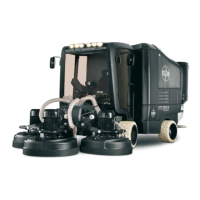SEBU7833-03 55
Maintenance Section
Battery or Battery Cable - Disconnect
i02323088
Battery or B attery Cable -
Disconnect
The battery c able s or the batteries should not be
removed with
the battery cover in place. The bat-
tery cover should be removed before any servic-
ing is attempted.
Removing the battery cables or the batteries with
the cover in place may cause a battery explosion
resulting in
personal injury.
1. Turn the start switch to the OFF position. Turn the
ignition sw
itch (if equipped) to the OFF position
and remove the key and all electrical loads.
2. Disconnect
the negative battery terminal. Ensure
that the cable cannot contact the terminal. When
four 12 volt batteries are involved, two negative
connection
must be disconnected.
3. Remove the positive connection.
4. Clean all disconnected connection and battery
terminals.
5. Use a fine grade of sandpaper to clean the
terminals and the cable clamps. Clean the items
until the s
urfaces are bright or shiny. DO NOT
remove material excessively. Excessive removal
ofmaterialcancausetheclampstonotfit
correctly
. Coat the clamps and the terminals with
a suitable silicone lubricant or petroleum jelly.
6. Tape the c
able connections in order to help
prevent accidental starting.
7. Proceed w
ith necessary system repairs.
8. In order to connect the battery, connect the
positive
connection before the negative connector.
i02203590
Cooling System Coolant
(Comm ercial H
eavy-Duty) -
Change
NOTICE
Care must be taken to ensure that fluids are contained
during performance of inspection, maintenance, test-
ing,adjustingand repair of the product. Be prepared to
collect the fluid with suitable containers before open-
ing any compartment or disassembling any compo-
nent containing fluids.
Dispose of all fluids according to Local regulations and
mandates.
NOTICE
Keep all part
s clean from contaminants.
Contaminants may cause rapid wear and shortened
component li
fe.
Clean the cooling system and flush the cooling
system before the recommended maintenance
interval if the following conditions exist:
•
The engine overheats frequently.
•
Foaming is observed.
•
The oil has entered the cooling system and the
coolant is contaminated.
•
The fuel has entered the cooling system and the
coolant is contaminated.
Note: When the cooling system is cleaned, only
clean water is needed.
Note: Inspect the water pump and the water
temperature regulator after the cooling system has
been drained. This is a good opportunity to replace
the water pump, the water temperature regulator and
the hoses, if necessary.
Drain
Pressurized System: Hot coolant can cause seri-
ous burns. To open the cooling sy stem filler cap,
stop the engine and wait until the cooling system
components are cool. Loosen the cooling system
pressure cap slowly in order to relieve the pres-
sure.
This document is printed from SPI². Not for Resale.

